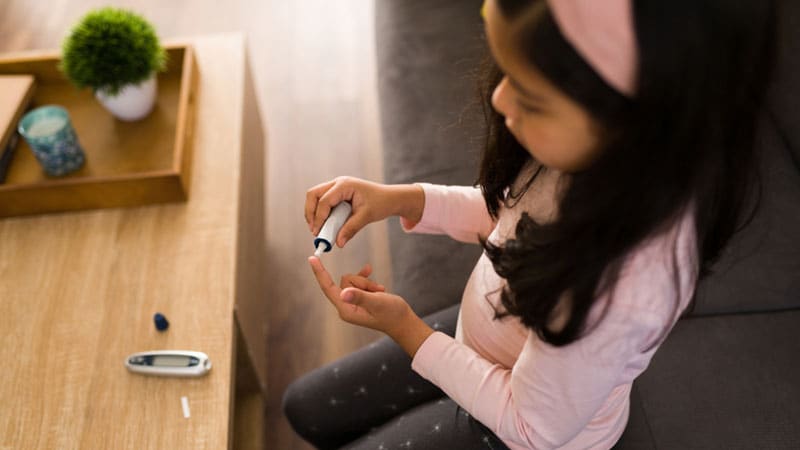

Finding symptoms of diabetic ketoacidosis at the time of diagnosis of type 1 diabetes is a frequent and alarming phenomenon in the pediatric population of Latin America because the complication is visible in up to 61% of new diagnoses and in 36% of cases it is classified as serious. It occurs more frequently at younger ages in patients with a lower body mass index and among those who do not have health insurance.[1]

Dr. Valeria Hirschler
“Diabetic ketoacidosis is a critical condition that should not be underestimated, as it has the potential to progress to diabetic coma and even death. It is an acute complication of diabetes that is often generated by delays in the diagnosis of diabetes. type 1 and lack of awareness about the disease,” he told Medscape in Spanish Dr. Valeria Hirschler, pediatrician specializing in nutrition and diabetes, coordinator of the epidemiology committee of the Argentine Diabetes Society (SAD), and lead author of the research that reflected the worrying results.
The study, published in Journal of Pediatric Health Care, was retrospective and included the participation of 30 specialized pediatric care centers from Argentina, Chile and Peru. The methodology provided information from 2,026 participants aged between 6 months and 18 years (women: 983; median age: 9.12 years). All had received the diagnosis of type 1 diabetes during the period between 2018 and 2022.
The frequency of diabetic ketoacidosis at the time of diagnosis was 60.7% (n = 1,229) and 36% (n = 447) of the episodes were classified as severe. The prevalence was higher at early ages: values of 70% were recorded in boys and girls under 6 years of age and 47.5% among those over 12 years of age. Furthermore, it was established that a lower body mass index and lack of health insurance are independent risk factors for such events.
“To our knowledge, there are no large studies in Latin America that have analyzed the frequency and severity of diabetic ketoacidosis at the onset of type 1 diabetes,” the authors of the text wrote, underlining how vital it is for the region to have a better understanding of these complications.
There is a lack of greater education in diabetes

Dr. Mabel Ferraro
Dr. Mabel Ferraro, pediatrician specializing in nutrition and diabetes, director of the postgraduate pediatric doctor specializing in nutrition at the Faculty of Medicine of the University of Buenos Aires, who did not participate in the study, considered that the research was important. “First, because it is a work carried out in Latin America, where publications are not as frequent as in so-called central countries, such as the United States or some in Europe. Furthermore, it is a multicenter study and the centers that participated are reference centers. and with experience in the subject”.
Regarding the results obtained, she commented that they worry her “very much”, since the prevalence reported in the region is much higher than that registered in some European countries, such as Sweden (19%), Denmark (21%), Norway ( 22%) and Germany (20%).
“For our patients to develop diabetic ketoacidosis, a serious situation with a risk of death, someone did not realize it before. That is, a child began to lose weight, was very thirsty and urinated a lot. And someone did not realize it” said Dr. Ferraro.
That is why it asks that health professionals in charge of providing care to boys and girls consider type 1 diabetes more during the pediatric consultation. Likewise, he believes that greater education is needed among the population regarding the pathology.
“First you have to think about diabetes to then be able to diagnose it. You have to take into account the cardinal symptoms and some risk elements that are pointed out in the article, for example, younger age. I think that is a very important message that this research leaves” , said Dr. Ferraro.
The specialist recalled how valuable it is for the subsequent evolution of diabetes to prevent children from being diagnosed with these complications. “It is known that patients who do not present with ketoacidosis have better pancreatic reserve. This guarantees fewer long-term complications and, we would say, more stable diabetes.”
The effectiveness of campaigns that seek to raise awareness about diabetes in health professionals and the general population has already been proven by other research and allows for earlier diagnoses, better clinical management and prevention of diabetic ketoacidosis. For this reason, the authors of the article also consider the implementation of this type of initiatives in Latin America to be crucial.
“The proactive commitment of doctors, nurses and nurses can help Latin American families quickly recognize the symptoms of diabetes, thus avoiding diabetic ketoacidosis and the need for hospitalization. There is a need to increase awareness to prevent delays in diagnosis, especially among younger children from economically disadvantaged backgrounds,” Dr. Hirschler asked.
Betting on public health in crisis contexts
Another interesting fact that the research provided is that boys and girls with health insurance had a lower frequency of diabetic ketoacidosis: 58.8% compared to 62.7% registered among those who did not have medical coverage. Furthermore, episodes classified as serious were less frequent for the first group (19.3% vs. 24.0%).
The article mentions the role that socioeconomic inequalities have in the increase in the prevalence of diabetic ketoacidosis. These complications are more common in contexts of low educational level, lack of health insurance and unemployment.
Dr. Ferraro recounted experiences during the socioeconomic crisis that Argentina suffered in 2001. “In our country there were centers, such as the Pedro de Elizalde Hospital, that during that year recorded an increase in the frequency of onset of diabetic ketoacidosis.”
In this research, during the period analyzed, 50% of the participants had medical coverage, but 86% were assisted in different public centers in the participating countries.
The authors pointed out that in Latin America children have access to health care, even despite not having health insurance. And through the public system they are able to find regular diabetes monitoring for free. However, those with medical coverage have the additional option of being treated at private health centers. And among other things, they tend to have greater access to advanced drugs.
Generally, health insurance for children in the region usually comes thanks to the stable employment of their parents, something that in contexts of economic crisis for some may be lacking. Hence the importance of equalizing access opportunities through public health.
Dr. Ferraro pointed out the importance of implementing educational programs in the general population to improve the worrying results obtained. In addition, she indicated that it is vital to improve children’s access to the health system. Even so, she sees the high percentage of patients with diabetes who consult public centers, even despite having health insurance, as something that prioritizes the public health of the region.
“I would say to health policy makers that the more economic difficulties and the more deprivation there are in a population, the greater the severity of the clinical situations associated with diseases will be. What we have within our reach is not to lose opportunities in health, to get closer to the population with fewer resources through educational programs and of course being attentive,” concluded Dr. Ferraro.
All authors of the article and Dr. Ferraro have disclosed no relevant financial relationships.

